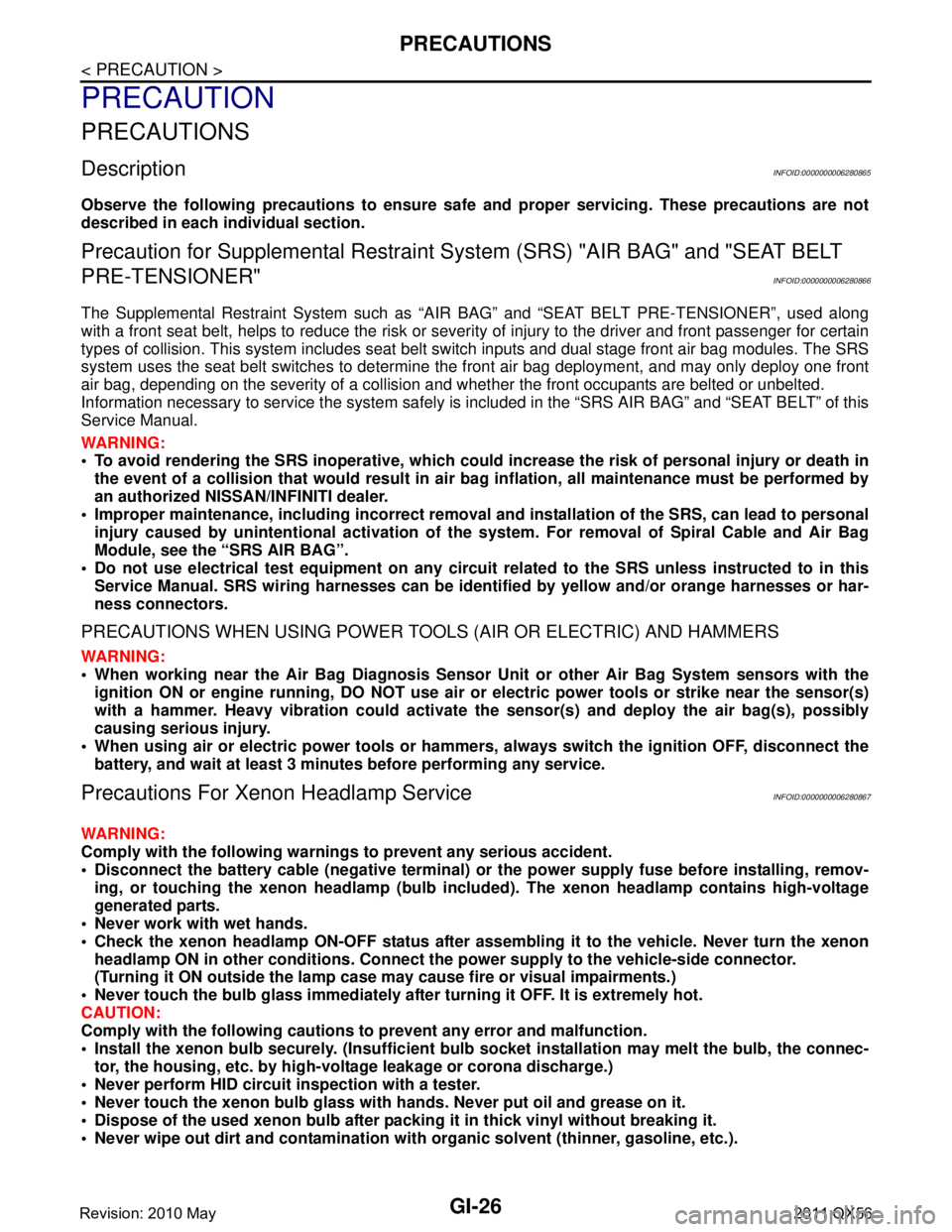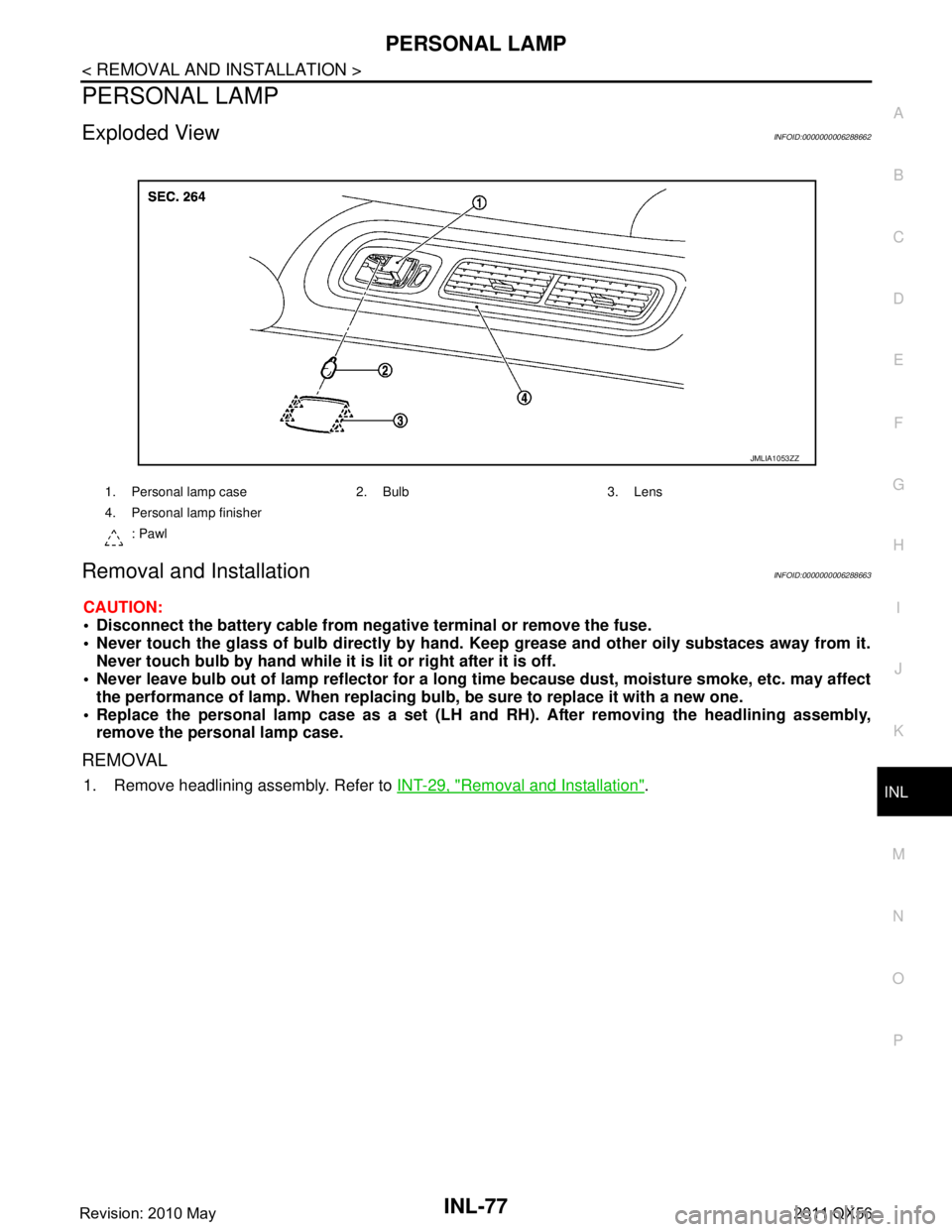2011 INFINITI QX56 BATTERY TERMINAL HEAD
[x] Cancel search: BATTERY TERMINAL HEADPage 2798 of 5598
![INFINITI QX56 2011 Factory Service Manual
EXL-88
< DTC/CIRCUIT DIAGNOSIS >[XENON TYPE]
HEADLAMP (LO) CIRCUIT
HEADLAMP (LO) CIRCUIT
Component Function CheckINFOID:0000000006213957
1.CHECK HEADLAMP (LO) OPERATION
CONSULT-III ACTIVE TEST
1. Sel INFINITI QX56 2011 Factory Service Manual
EXL-88
< DTC/CIRCUIT DIAGNOSIS >[XENON TYPE]
HEADLAMP (LO) CIRCUIT
HEADLAMP (LO) CIRCUIT
Component Function CheckINFOID:0000000006213957
1.CHECK HEADLAMP (LO) OPERATION
CONSULT-III ACTIVE TEST
1. Sel](/manual-img/42/57033/w960_57033-2797.png)
EXL-88
< DTC/CIRCUIT DIAGNOSIS >[XENON TYPE]
HEADLAMP (LO) CIRCUIT
HEADLAMP (LO) CIRCUIT
Component Function CheckINFOID:0000000006213957
1.CHECK HEADLAMP (LO) OPERATION
CONSULT-III ACTIVE TEST
1. Select “EXTERNAL LAMPS” of IPDM E/R active test item.
2. With operating the test items, che ck that the headlamp (LO) is turned ON.
Is the inspection result normal?
YES >> Headlamp (LO) is normal.
NO >> Refer to EXL-88, "
Diagnosis Procedure".
Diagnosis ProcedureINFOID:0000000006213958
1.CHECK HEADLAMP (LO) OUTPUT VOLTAGE
CONSULT-III ACTIVE TEST
1. Turn ignition switch OFF.
2. Disconnect front combination lamp connector.
3. Turn ignition switch ON.
4. Select “EXTERNAL LAMPS” of IPDM E/R active test item.
5. With operating the test items, check vo ltage between IPDM E/R harness connector and ground.
Is the inspection result normal?
YES >> GO TO 2.
NO >> GO TO 3.
2.CHECK HEADLAMP (LO) OPEN CIRCUIT
1. Turn ignition switch OFF.
2. Disconnect IPDM E/R connector.
3. Check continuity between IPDM E/R harness connec tor and front combination lamp harness connector.
Is the inspection result normal?
YES >> GO TO 5.
NO >> Repair or replace harness.
3.CHECK HEADLAMP (LO) FUSE
1. Turn ignition switch OFF.
2. Check that the following fuses are not fusing. Lo : Headlamp (LO) ON
Off : Headlamp (LO) OFF
(+)
(− ) Test item Vo l ta g e
(Approx.)
IPDM E/R
Connector Terminal
RH E1552
GroundEXTERNAL
LAMPS Lo Battery voltage
Off 0 V
LH 51 Lo Battery voltage
Off 0 V
IPDM E/R Front combination lamp Continuity
Connector Terminal Connector Terminal
RH E1552 E119
5 Existed
LH 51 E118
Revision: 2010 May2011 QX56
Page 2836 of 5598
![INFINITI QX56 2011 Factory Service Manual
EXL-126
< REMOVAL AND INSTALLATION >[XENON TYPE]
FRONT COMBINATION LAMP
Disconnect the battery negative terminal or remove the fuse.
1. Remove front grille. Refer to
EXT-19, "
Removal and Installati INFINITI QX56 2011 Factory Service Manual
EXL-126
< REMOVAL AND INSTALLATION >[XENON TYPE]
FRONT COMBINATION LAMP
Disconnect the battery negative terminal or remove the fuse.
1. Remove front grille. Refer to
EXT-19, "
Removal and Installati](/manual-img/42/57033/w960_57033-2835.png)
EXL-126
< REMOVAL AND INSTALLATION >[XENON TYPE]
FRONT COMBINATION LAMP
Disconnect the battery negative terminal or remove the fuse.
1. Remove front grille. Refer to
EXT-19, "
Removal and Installation".
2. Remove front bumper molding. Refer to EXT-13, "
Removal and Installation".
3. Remove front bumper fascia. Refer to EXT-13, "
Removal and Installation".
4. Remove headlamp mounting bolts.
5. Pull out headlamp assembly forward vehicle.
6. Disconnect connectors before removing headlamp assembly.
INSTALLATION
Install in the reverse order of removal.
NOTE:
After installation, perform aiming adjustment. Refer to EXL-121, "
description".
ReplacementINFOID:0000000006369465
CAUTION:
Disconnect the battery negative terminal or remove the fuse.
After installing the bulb, install the resin cap and the bulb socket securely for watertightness.
Never touch the glass of bu lb directly by hand. Keep grease an d other oily matters away from it.
Never touch bulb by hand while it is lit or right after being turned off.
Never leave bulb out of lamp reflector for a long ti me because dust, moisture smoke, etc. may affect
the performance of lamp. When replacing bulb, be sure to replace it with new one.
HEADLAMP BULB (HI/LO)
1. Remove fender protector. Refer to EXT-23, "FENDER PROTECTOR : Removal and Installation".
2. Rotate resin cap counterclockwise and unlock it.
3. Rotate bulb socket counterclockwise and unlock it.
4. Remove retaining spring lock. And then remove bulb from headlamp housing assembly.
CAUTION:
Never break the xenon bulb ceramic tube when replacing
the bulb.
PARKING LAMP BULB
1. Remove hood switch*.
*:When replace a right.
2. Rotate bulb socket counterclockwise and unlock it.
3. Remove bulb from bulb socket.
FRONT TURN SIGNAL LAMP BULB
1. Remove hood switch*.
*:When replace a right.
2. Rotate bulb socket counterclockwise and unlock it.
3. Remove bulb from bulb socket.
SIDE MARKER LAMP BULB
1. Remove fender protector. Refer to EXT-23, "FENDER PROTECTOR : Removal and Installation"
2. Rotate bulb socket counterclockwise and unlock it.
3. Remove bulb from bulb socket.
JPLIA0919ZZ
Revision: 2010 May2011 QX56
Page 2965 of 5598

GI-1
GENERAL INFORMATION
C
DE
F
G H
I
J
K L
M B
GI
SECTION GI
N
O P
CONTENTS
GENERAL INFORMATION
HOW TO USE THIS MANU AL ......................3
HOW TO USE THIS MANUAL ....................... .....3
Description .......................................................... ......3
Terms ........................................................................3
Units ..........................................................................3
Contents ....................................................................3
Relation between Illustrations and Descriptions .......4
Components ..............................................................4
HOW TO FOLLOW TROUBLE DIAGNOSES .....6
Description ................................................................6
How to Follow Test Groups in Trouble Diagnosis ......6
Key to Symbols Signifying Measurements or Pro-
cedures ............................................................... ......
7
HOW TO READ WIRING DIAGRAMS ................9
Connector Symbols ............................................. ......9
Sample/Wiring Diagram -Example- .........................10
Connector Information .............................................12
ABBREVIATIONS .......................................... ....14
Abbreviation List .................................................. ....14
TIGHTENING TORQUE OF STANDARD
BOLTS ................................................................
19
Description .......................................................... ....19
Tightening Torque Table (New Standard Includ-
ed) ...........................................................................
19
RECOMMENDED CHEMICAL PRODUCTS
AND SEALANTS ................................................
22
Recommended Chemical Products and Sealants ....22
VEHICLE INFORMATION ............................23
IDENTIFICATION INFORMATION ................. ....23
Model Variation ................................................... ....23
Information About Identification or Model Code ......23
Dimensions .............................................................25
Wheels & Tires ........................................................25
PRECAUTION ..............................................26
PRECAUTIONS .................................................26
Description ........................................................... ....26
Precaution for Supplemental Restraint System
(SRS) "AIR BAG" and "SEAT BELT PRE-TEN-
SIONER" .................................................................
26
Precautions For Xenon Headlamp Service .............26
Precaution Necessary for Steering Wheel Rota-
tion after Battery Disconnect ...................................
27
Precaution for Procedure without Cowl Top Cover ....27
General Precautions ................................................27
Three Way Catalyst .................................................29
Multiport Fuel Injection System or Engine Control
System .....................................................................
29
Hoses ......................................................................29
Engine Oils ..............................................................30
Air Conditioning .......................................................31
Fuel ..........................................................................31
LIFTING POINT .................................................32
Pantograph Jack ......................................................32
Garage Jack and Safety Stand ................................32
2-Pole Lift ................................................................33
TOW TRUCK TOWING .....................................34
Tow Truck Towing ...................................................34
Vehicle Recovery (Freeing a Stuck Vehicle) ...........34
BASIC INSPECTION ...................................36
SERVICE INFORMATION FOR ELECTRICAL
INCIDENT ..........................................................
36
Work Flow ............................................................ ....36
Control Units and Electrical Parts ............................36
How to Check Terminal ...........................................37
Intermittent Incident .................................................40
Circuit Inspection .....................................................43
CONSULT-III/GST CHECKING SYSTEM .........48
Description ...............................................................48
CONSULT-III Function and System Application*1 ....48
Revision: 2010 May2011 QX56
Page 2990 of 5598

GI-26
< PRECAUTION >
PRECAUTIONS
PRECAUTION
PRECAUTIONS
DescriptionINFOID:0000000006280865
Observe the following precautions to ensure safe and proper servicing. These precautions are not
described in each individual section.
Precaution for Supplemental Restraint S ystem (SRS) "AIR BAG" and "SEAT BELT
PRE-TENSIONER"
INFOID:0000000006280866
The Supplemental Restraint System such as “A IR BAG” and “SEAT BELT PRE-TENSIONER”, used along
with a front seat belt, helps to reduce the risk or severi ty of injury to the driver and front passenger for certain
types of collision. This system includes seat belt switch inputs and dual stage front air bag modules. The SRS
system uses the seat belt switches to determine the front air bag deployment, and may only deploy one front
air bag, depending on the severity of a collision and w hether the front occupants are belted or unbelted.
Information necessary to service the system safely is included in the “SRS AIR BAG” and “SEAT BELT” of this
Service Manual.
WARNING:
To avoid rendering the SRS inopera tive, which could increase the risk of personal injury or death in
the event of a collision that would result in air bag inflation, all maintenance must be performed by
an authorized NISS AN/INFINITI dealer.
Improper maintenance, including in correct removal and installation of the SRS, can lead to personal
injury caused by unintent ional activation of the system. For re moval of Spiral Cable and Air Bag
Module, see the “SRS AIR BAG”.
Do not use electrical test equipmen t on any circuit related to the SRS unless instructed to in this
Service Manual. SRS wiring harnesses can be identi fied by yellow and/or orange harnesses or har-
ness connectors.
PRECAUTIONS WHEN USING POWER TOOLS (AIR OR ELECTRIC) AND HAMMERS
WARNING:
When working near the Air Bag Diagnosis Sensor Unit or other Air Bag System sensors with the
ignition ON or engine running, DO NOT use air or electric power tools or strike near the sensor(s)
with a hammer. Heavy vibration could activate the sensor(s) and deploy the air bag(s), possibly
causing serious injury.
When using air or electric power tools or hammers , always switch the ignition OFF, disconnect the
battery, and wait at least 3 minu tes before performing any service.
Precautions For Xenon Headlamp ServiceINFOID:0000000006280867
WARNING:
Comply with the following warnings to prevent any serious accident.
Disconnect the battery cable (negative terminal) or the power supply fuse before installing, remov-
ing, or touching the xenon headlamp (bulb included). The xenon headlamp contains high-voltage
generated parts.
Never work with wet hands.
Check the xenon headlamp ON-OFF status after assembling it to the vehicle. Never turn the xenon
headlamp ON in other conditions. Connect th e power supply to the vehicle-side connector.
(Turning it ON outside the lamp case m ay cause fire or visual impairments.)
Never touch the bulb glass immediately after turning it OFF. It is extremely hot.
CAUTION:
Comply with the following cautions to prevent any error and malfunction.
Install the xenon bulb securely. (Ins ufficient bulb socket installation may melt the bulb, the connec-
tor, the housing, etc. by high-v oltage leakage or corona discharge.)
Never perform HID circuit in spection with a tester.
Never touch the xenon bulb glass with ha nds. Never put oil and grease on it.
Dispose of the used xenon bulb after packing it in thick vinyl without breaking it.
Never wipe out dirt and cont amination with organic solven t (thinner, gasoline, etc.).
Revision: 2010 May2011 QX56
Page 3344 of 5598

PERSONAL LAMPINL-77
< REMOVAL AND INSTALLATION >
C
DE
F
G H
I
J
K
M A
B
INL
N
O P
PERSONAL LAMP
Exploded ViewINFOID:0000000006288662
Removal and InstallationINFOID:0000000006288663
CAUTION:
Disconnect the battery cable from negative terminal or remove the fuse.
Never touch the glass of bulb directly by hand. Keep grease and other oily substaces away from it.
Never touch bulb by hand while it is lit or right after it is off.
Never leave bulb out of lamp reflector for a long time because dust, moisture smoke, etc. may affect
the performance of lamp. When replacing bu lb, be sure to replace it with a new one.
Replace the personal lamp case as a set (LH a nd RH). After removing the headlining assembly,
remove the personal lamp case.
REMOVAL
1. Remove headlining assembly. Refer to INT-29, "Removal and Installation".
1. Personal lamp case 2. Bulb 3. Lens
4. Personal lamp finisher
: Pawl
JMLIA1053ZZ
Revision: 2010 May2011 QX56
Page 4627 of 5598
![INFINITI QX56 2011 Factory Service Manual
SEC-20
< SYSTEM DESCRIPTION >[WITH INTELLIGENT KEY SYSTEM]
SYSTEM
this time, if BCM still detects unauthorized access to t
he vehicle, the system is switched to the ALARM phase
again. This RE-ALARM o INFINITI QX56 2011 Factory Service Manual
SEC-20
< SYSTEM DESCRIPTION >[WITH INTELLIGENT KEY SYSTEM]
SYSTEM
this time, if BCM still detects unauthorized access to t
he vehicle, the system is switched to the ALARM phase
again. This RE-ALARM o](/manual-img/42/57033/w960_57033-4626.png)
SEC-20
< SYSTEM DESCRIPTION >[WITH INTELLIGENT KEY SYSTEM]
SYSTEM
this time, if BCM still detects unauthorized access to t
he vehicle, the system is switched to the ALARM phase
again. This RE-ALARM operation is carried out a maximum of 2 times.
To cancel the ALARM operation, refer to the switching condition of No. 12 in the table above.
NOTE:
If a battery terminal is disconnected during the ALARM phase, theft warning alarm stops. But when the battery
terminal is reconnected, theft warning alarm is activated again.
PRE-RESET Phase
The PRE-RESET phase is the transient state betw een each phase and DISARMED phase. If only the condi-
tion of hood is not satisfied, the system switches to the PRE-RESET phase. Then, when any condition is
changed, the system switches to t he DISARMED phase or PRE-ARMED phase.
PANIC ALARM
The panic alarm function activates horns and headlamps intermittently when the owner presses the PANIC
ALARM button of Intelligent Key outside the vehicle while the power supply position is OFF or LOCK.
When BCM receives panic alarm signal from Intelligent Key, BCM transmits “Theft Warning Horn Request”
signal and “High Beam Request” signal intermittently to IPDM E/R via CAN communication. To prevent the
activation due to mis-operation of Intelligent Key by ow ner, the panic alarm function is activated when BCM
receives the signal for 0.4 - 0.6 seconds.
Panic alarm operation is maintained for 25 seconds.
Panic alarm operation is cancelled when BCM receives one of the following signals.
- LOCK button of Intelligent Key: ON
- UNLOCK button of Intelligent Key: ON
- PANIC ALARM button of Intelligent Key: Long pressed
- Any door request switch: ON
Revision: 2010 May2011 QX56
Page 4782 of 5598

SIDE CURTAIN AIR BAG MODULESR-19
< REMOVAL AND INSTALLATION >
C
DE
F
G
I
J
K L
M A
B
SR
N
O P
SIDE CURTAIN AIR BAG MODULE
Exploded ViewINFOID:0000000006113059
Removal and InstallationINFOID:0000000006113060
WARNING:
Before servicing, turn ignition switch OFF, disconnect battery ne gative terminal and wait 3 minutes
or more.
Always work from the side of air bag module. Never work in front of it.
Never use the air tools or el ectric tools for servicing.
REMOVAL
1. Remove the headlining assembly. Refer to INT-29, "Removal and Installation".
2. Remove the side curtain air bag module harness connector. CAUTION:
1. Side curtain air bag
*: Side curtain air bag RH side only
Refer to GI-4, "
Components" for symbols in the figure.
JMHIA1474GB
Revision: 2010 May2011 QX56
Page 5565 of 5598

WW-46
< DTC/CIRCUIT DIAGNOSIS >
HEADLAMP WASHER RELAY
HEADLAMP WASHER RELAY
Component InspectionINFOID:0000000006371494
1.CHECK HEADLAMP WASHER RELAY
1. Turn the ignition switch OFF.
2. Remove headlamp washer relay.
3. Apply battery voltage to headlamp washer relay between terminals 1 and 2.
4. Check continuity of headlamp washer relay.
Does continuity exist?
YES >> Headlamp washer relay is normal.
NO >> Replace headlamp washer relay.
Headlamp washer relay Condition Continuity
Terminal Voltage
35 Apply Existed
Not Apply Not existed
Revision: 2010 May2011 QX56